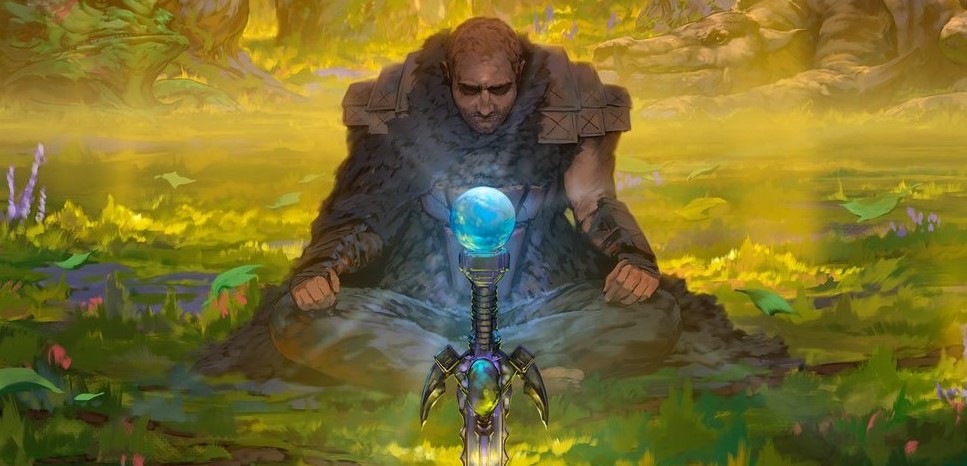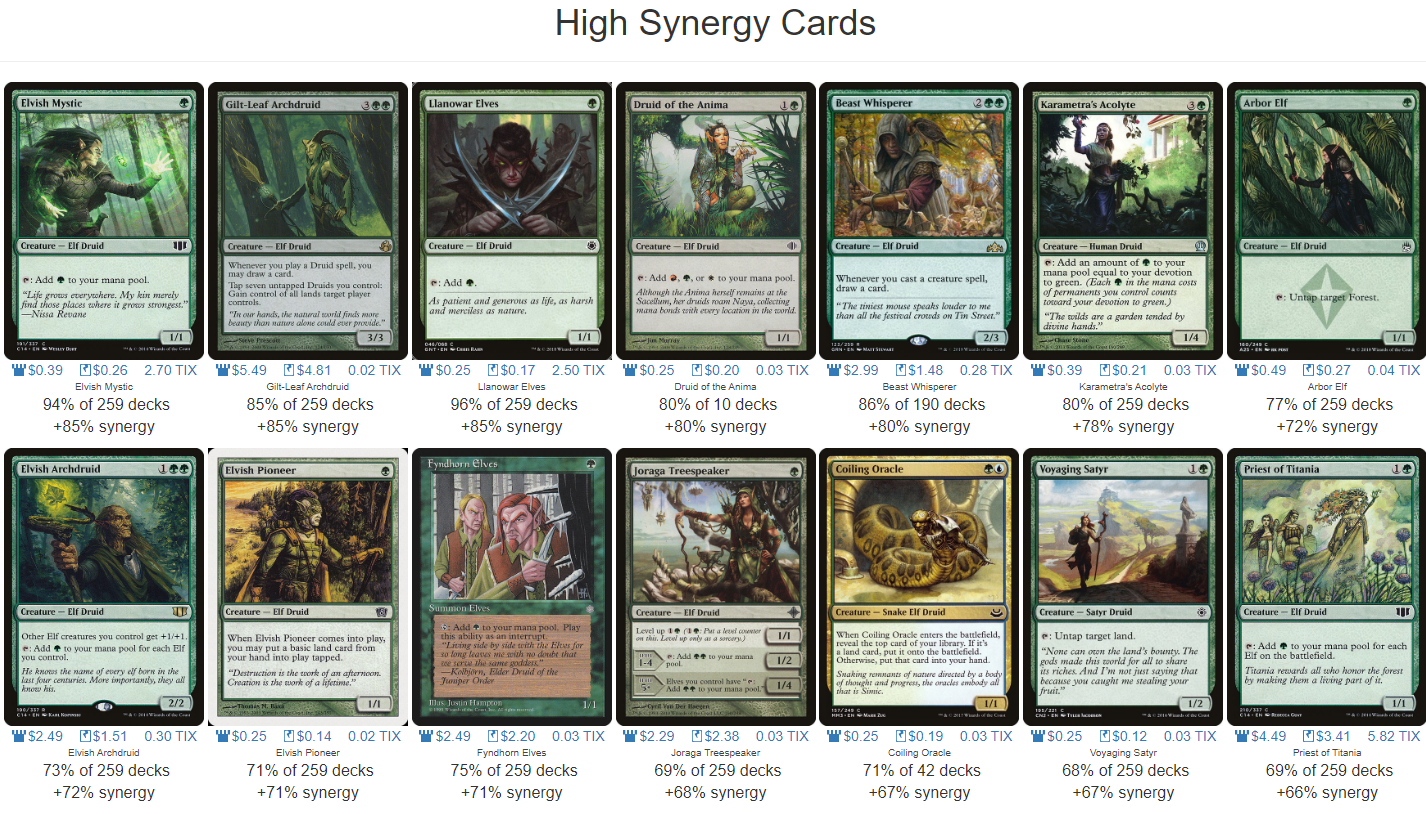Rolebuilding - Nature’s Crusade

(Kamahl's Druidic Vow | Art by Noah Bradley)
Introduction
Welcome to Rolebuilding, where I blend my fraternal-twin hobbies of tabletop roleplaying games and Magic: The Gathering for your delight and amusement! In this series we’ll choose a role or character from the realms of Dungeons & Dragons and embark on a quest based on their motivations. The quest will serve as our guide when building the deck’s strategy and win conditions. Sound fun? Of course! Who says you can’t play two games at once?
Stepping Out Your Door
In this inaugural installment we’ll be assuming the role of Melora, goddess of nature and the sea. According to the Dungeons and Dragons 4th Edition Player’s Handbook, Melora is revered by hunters and rangers as the protector of wilderness and is a staunch opponent of civilized sprawl. We embolden our followers to reclaim places that were once wild and to hunt unnatural abominations. With this in mind, let’s take a look at the tribes page on EDHREC and see what sort of disciples we can recruit to support our agenda.
A few options immediately jump off the page: Elves, Merfolk, and Elementals. All have powerful tribal synergies and a broad card pool to choose from in colors that fit our disposition. These are viable options, but let’s look deeper. One of the handy features on the tribes page is that it shows you the most commonly played creature from each tribe. These paragon creatures are often indicative of what we’ll find within each tribe, but in this case it leads us right to our new chief priest:
Gilt-Leaf Archdruid rewards us with card draw for playing more Druids, and then we can tap those creatures to steal reclaim our opponents' lands. What better way to protect the wilderness than by securing all of it under our control? The Archdruid is the only card that can take all of an opponent’s lands in one fell swoop (sorry, Herald of Leshrac, you're too slow). As our chief priest, he will form the centerpiece of our strategy.
Our quest has taken shape: reclaim lands on behalf of the wilderness in order to protect the natural realms. Once we’ve reclaimed these lands, we still need to win the game, and quickly, lest our fictitious quest invite the real-life wrath of our now landless opponents. We’ll complete our quest in poetic fashion by beating the trespassers into submission with the very lands they previously claimed as their own. Nature is savage and that’s OK.
Though Kamahl, Fist of Krosa is not the commander for this deck, we'll be using him as our primary quest finisher/win con. I like to have my end goal in mind both when roleplaying and deckbuilding.
Every God Needs Worshippers
We know that green can tutor for creatures, often quite effectively, so finding our key Druids shouldn't be much of a problem. There are two important questions we need to answer. First, what sort of ramp strategy will we deploy to pull off this resource-heavy strategy? Second, how do we assemble seven Druids quickly and sneakily without our opponents disrupting our strategy? Let’s start with the Druid tribes page and see what we can find.
That answers our first question! Druids like ramping, and most ramp druids belong in one of two camps: mana dorks and land untappers. We’ll focus on the land untappers since it fits the flavor of asking our followers to safeguard the land. It also synergizes with the gameplan of reclaiming our opponents' lands and attacking with them.
In addition to early pieces like Voyaging Satyr, we’ll want some bigger payoffs like Krosan Restorer for ramping into our mid-game strategies. Not only will these creatures accelerate our gameplan, but they'll become important combo pieces late in the game. More to come on that, later.
Some Druids provide us with raw card advantage, including all-stars like Beast Whisperer, Voice of Many, and Coiling Oracle.
Hold on. Coiling Oracle? Aren’t Druid decks mono-green? We are the goddess of the sea, so blue does fit the bill. Less than 1% of all Druid Tribal decks are Simic, but that doesn’t mean great options don’t exist for Druid commanders in these colors. It’s about time for us to pick a commander!
One With the Land
Seton, Krosan Protector commands more Druid Tribal decks than all of the other Druid commanders combined. But we’ve already determined that we aren’t as interested in the mana dork side of Druidity, so we can take a pass on him. There is one clear option that fits the flavor bill of our quest and incorporates our sea domain.
As the most popular Simic commander, Tatyova, Benthic Druid helms a whopping 1,623 decks at the time of this writing. Despite having Druid in her name, she pilots just seven Druid tribal decks. Seven! I love that EDHREC filters can bring this sort of gold to the surface by casting a broad net. If I had started with a commander-first approach and found myself on Tatyova’s Commander page, I could have found Druid Tribal nestled at the bottom of the Themes section despite only .003% of Tatyova decks meeting the requirements for Druid Tribal. If you want to build a fringe strategy with an established commander, you don't have to be on a delusional mission like I am; you can approach the situation from several angles.
Tatyova, Benthic Druid hits all three notes for us: flavor, power, and supporting our quest as a Druid. Now that we’ve settled on a commander, we’re better-positioned to satisfy the other burning question: how do we assemble seven Druids?
These Are Not The Druids You’re Looking For
You may have noticed that the High Synergy and Top Cards sections of the Druids Tribal page are regrettably devoid of token-creators. Unlike Elves, Druids don't excel at self-replication. In fact there are only two cards in all of Magic that create Druid tokens, not including cards that create Changeling tokens or that let you decide the creature type, like Riptide Replicator.
We’ll include both of these for good measure, but we’re going to need more help in order to reach critical Druid mass. We could stick close to the Druid tribal theme, plan on hard-casting loads of dorky, suboptimal Druids, and cross our fingers that a board wipe doesn’t set us way back. But since we’ve introduced blue to the mix, new avenues of play present themselves. We no longer need to create seven Druids, like a Seton deck would need to. We just need to make seven creatures and then convert them to Our New Druid Way™, the brand-new religion of Melora that I just created right now. I have spoken.
Standardize is particularly powerful here as it allows us to execute our strategy on an opponent’s end step with total surprise. Let’s say we start with an innocuous board state of two land-untappers and four tokens (say, Saprolings or Elves). On our opponent's end step we cast Chord of Calling to play Gilt-Leaf Archdruid from our library, cast Standardize choosing Druid, and then activate the Archdruid to nab all of that opponent's lands just before our untap step. Cool!
Let’s take a trip past the Tokens Theme page to see what would-be Druid-makers we can recruit.
Saprolings, Thopters and Plants are some low-cost tokens we can generate in our colors. From the Tokens page, we can click Related Info to find more specifics on Saprolings or Thopters. Since Saprolings fit our all-natural theme, let’s head that direction.
Mycoloth’s power is undeniable, and he puts a great deal of pressure on our opponents. Sprout Swarm and Jade Mage, though not very efficient, have the added benefit of being useful instant-speed mana sinks if we're able to generate infinite mana. Remember earlier when I said our land-untapping Druids would also be combo pieces?
Intruder Alarm allows us to go infinite in a dizzying number of ways, as this card tends to do. If we can keep creating tokens with Sprout Swarm or Jade Mage and untapping our Druids like Krosan Restorer, then we can make as many tokens as we fancy, or we can finish off the table with a lethal Squall Line. The untap party is all the more potent if we’ve dropped a Dictate of Karametra or flipped our Growing Rites of Itlimoc. It’s not easy to tutor for a three-mana enchantment in our colors, but Drift of Phantasms and Long-Term Plans can fetch either of the above, as well as Arcane Adaptation, making them important consistency pieces as we try to get our fledgling religion off the ground.
We aren't formally a Landfall deck, so Retreat to Coralhelm seems a little out of place in this menagerie until we put the final pieces into place. Behold, the final converts to our reclaimers' crusade:
These supplicants come down early and work swimmingly with our commander. I’m not surprised to find that they're played in 48% (Llanowar Scout), 43% (Sakura-Tribe Scout) and 36% (Walking Atlas) of all Tatyova decks. Looking further down Tatyova’s Commander page, I am surprised to see only 18% of her decks run Ghost Town. With one of the scouts above, Retreat to Coralhelm, and Tatyova on the battlefield, you can repeatedly flicker Ghost Town on your opponent's upkeep to draw your deck and gain tons of life, then cast Squall Line from your hand for 60-ish damage to kill everyone else at the table. Sometimes gods need to take matters into their own hands.
Now that we’ve outlined our quest, goals, and side quests, a.k.a alternative win cons, we need to throw down the decklist. Here is what Melora, Goddess of Nature and the Sea’s deck might look like if she wanted to take back nature from trespassing mortals.
Though Melora is above reproach, I am curious to hear your thoughts on the first installment of Rolebuilding. Were there some cards I missed that would have tickled Melora’s fancy? What are your thoughts on structuring the deck around a particular D&D character and quest? I’d really appreciate it if you dropped a comment below! Until next time, happy games!

EDHREC Code of Conduct